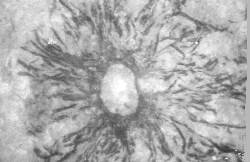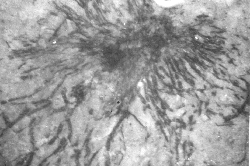
| Medusaegraptus sp. from the Silurian of Gotland, Sweden |


The fossil genus Medusaegraptus was erected by Rudolf Ruedemann as a graptolite taxon. Its algal
nature was suggested by Hede (1960) and Bulman (1970). Mierzejewski (1986) placed this genus
among the Codiaceae (green algae Chlorophyceae) and interpreted "thecae" of this "graptolite" as
thallus threads (see here). On the contrary, Lo Duca (1990) discussed Medusaegraptus mirabilis as
a noncalcified dasyclad alga.
nature was suggested by Hede (1960) and Bulman (1970). Mierzejewski (1986) placed this genus
among the Codiaceae (green algae Chlorophyceae) and interpreted "thecae" of this "graptolite" as
thallus threads (see here). On the contrary, Lo Duca (1990) discussed Medusaegraptus mirabilis as
a noncalcified dasyclad alga.
Medusaegraptus sp. from the Wenlock (Halla Beds) of Gotland, Möllbos, Sweden.
These fossils were found associated with the rich assemblage of various organic microfossils: Tasmanites sp.,
Acanthochitina sp., Ordovicina oligostoma Eisenack; jaws of Polychaeta: Paulinites sp., Rakvereprion sp.,
"Nothrites" sp., Mochtyella spp., Xanioprion sp., Ramphoprion sp; pterobranch and graptolite hemichordates:
Kystodendron sp., Epigraptus kozlowskii Mierzejewski, Epigraptus ex gr. bilinguis Kozlowski,
Reticulograptus, Urbanekicrusta reversa Mierzejewski, Mastigograptus sp. Crustoidea gen. et sp. indet.; and
remnants of the Eurypterida.
These fossils were found associated with the rich assemblage of various organic microfossils: Tasmanites sp.,
Acanthochitina sp., Ordovicina oligostoma Eisenack; jaws of Polychaeta: Paulinites sp., Rakvereprion sp.,
"Nothrites" sp., Mochtyella spp., Xanioprion sp., Ramphoprion sp; pterobranch and graptolite hemichordates:
Kystodendron sp., Epigraptus kozlowskii Mierzejewski, Epigraptus ex gr. bilinguis Kozlowski,
Reticulograptus, Urbanekicrusta reversa Mierzejewski, Mastigograptus sp. Crustoidea gen. et sp. indet.; and
remnants of the Eurypterida.
| _______________________________________________________________________________________ GRAPTOLITE NET is edited by Piotr Mierzejewski, the Count of Calmont since 2002 |
| Photo: Piotr Mierzejewski |
J. Ernhold Hede (1960) wrote:
"The most notable fossil occuring in this rock is a form not previously reported and,
as far as is known, nowhere else found in Gotland. The form which is only sparingly met
with, appears to represent Medusaegraptus (Ruedemann 1925), a genus generally, though
with some doubt, referred to the Graptolithina (order Dendroidea) but is possibly
algal. The specimens found apparently represent one and the same species, probably
being new to science. The mode of occurence and embedding in the sediment of most of
the examples met with (by the present writer) indicate that the organism was a
sea-bottom-dwelling and anchored in position by attachment to the bottom. The
stratified limestone and marlstone mentioned may be interpreted as lagoon deposits."
Related page: Medusaegraptus from the Ordovician of China
"The most notable fossil occuring in this rock is a form not previously reported and,
as far as is known, nowhere else found in Gotland. The form which is only sparingly met
with, appears to represent Medusaegraptus (Ruedemann 1925), a genus generally, though
with some doubt, referred to the Graptolithina (order Dendroidea) but is possibly
algal. The specimens found apparently represent one and the same species, probably
being new to science. The mode of occurence and embedding in the sediment of most of
the examples met with (by the present writer) indicate that the organism was a
sea-bottom-dwelling and anchored in position by attachment to the bottom. The
stratified limestone and marlstone mentioned may be interpreted as lagoon deposits."
Related page: Medusaegraptus from the Ordovician of China